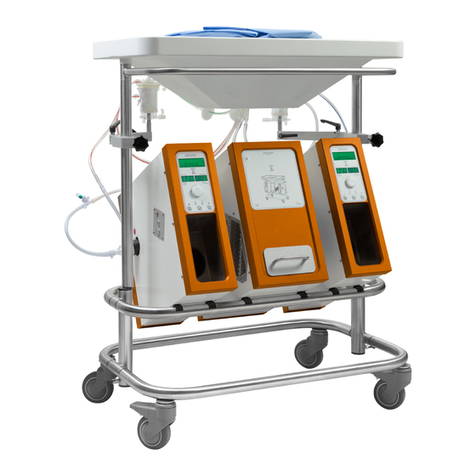XVIVO Perfusion System (XPSTM) Instrucons for Use -8- P/N: 9182-0189 Revision Q
The primary mode of action for
STEEN Solution™ is its ability to
provide optimal colloid-osmotic
pressure (COP), permitting stable
fluid compartment homeostasis for
sufficient time to allow meaningful
functional evaluation of the lung at
37°C. STEEN SolutionTM therefore
mimics the in vivo situation with-
out the risk of edema formation in
the absence of harmful pro-
inflammatory cytokines and
activated leucocytes associated
with trauma, stress and brain
death. This mode of action is
primarily related to the water
binding properties of albumin and
its distributions across semi-
permeable membranes between
the intra- and extra-vascular spac-
es within the lung, and is not
based on any metabolic or
pharmacological action of either
colloid.
1.1 GENERAL OVERVIEW
STEEN Soluon™ is a clear, sterile, non-pyrogenic, non-toxic physiological
salt soluon containing human serum albumin (HSA) and dextran 40. This
soluon is an extracellular (low potassium) electrolyte soluon with physio-
logical colloid-osmoc pressure (COP) designed for use as a temporary con-
nuous normothermic machine perfusion soluon for assessment of inially
unacceptable isolated lungs aer removal from the donor in preparaon for
eventual transplantaon into a recipient.
The composion of STEEN Soluon™ was
designed to simulate the colloid-osmoc
pressure (COP) and crystalloid-osmoc
properes of human plasma to permit safe,
connuous ex vivo lung perfusion at
normothermia for up to 6 hours without the
development of either ssue edema or de-
hydraon - i.e. the COP and osmoc pres-
sure of the soluon were chosen to maintain
opmal water balance between the cellular
and the intra- and extra-vascular spaces.
The opmal (iso-oncoc) COP is provided by
a proprietary combinaon of human
albumin and dextran 40. The electrolyte
composion is essenally extra-cellular
(low K+) with a phosphate buer.
STEEN Soluon™ is intended to be used with the XVIVO Perfusion System
(XPSTM) for ushing and temporary connuous normothermic machine
perfusion of inially unacceptable excised donor lungs during which me
the funcon of the lungs can be reassessed for transplantaon. The me
required by the lungs to reverse the negave eects of neurogenic
pulmonary edema and to achieve a normal uid balance can vary based on
the inial donor environment.
Typically, the duraon of normothermic machine perfusion lasts 3-5 hours
(per FDA PMA approval) 3-6 hours (per FDA Novel Extension Study and CE
approval) to allow the lungs to slowly warm up, normalize uid balance and
be eecvely assessed. In exceponal cases, an addional 1-2 hours may
be needed for the lung to be adequately reassessed to allow assessment for
transplantaon suitability:
1
STEEN SolutionTM
5 hr (FDA)
6 hr (Novel Extension / CE)
3 - 5hr (FDA)
3 - 5 hr (Novel Extension) / CE
2 hr
1 hr30 min
2 hr1 hr30 min




























